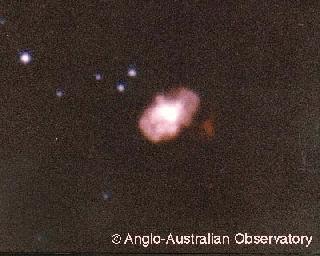
| Right Ascension | 10 : 45 : 03.6 (h:m:s) |
|---|---|
| Declination | -59 : 41 : 03 (deg:m:s) |
| Distance | 10,000 (ly) |
| Visual brightness | -0.8 .. 7.9 (mag) |
| Spectra type | Pec |
Eta Carinae was first cataloged by Edmond Halley in 1677 as a star of fourth magnitude. Variability discovered by Burchell in 1827.
In 1730, its brightness reached mag 2, and again fell to mag 4 in about 1782. It brightened again about 1801 and faded back to 4th magnitude in 1811. In 1820, Eta began to brighten steadily, reaching 2nd magnitude in 1822 and 1st mag in 1827. After this first preliminary maximum, the star faded back to mag 2 for about 5 years, then rose again to about mag 0. After a further slight decline, Eta's brightness incresed once more and reached its maximal brilliance of nearly -1.0 in April 1843, when it outshone all stars in the sky but Sirius. After this brilliant show, the star slowly faded continuously, and became invisible in 1868. Interrupted by two minor outbursts around 1870 and 1889, Eta Carinae faded to about 8th magnitude around 1900, where it remained until 1941. At that time, the star began to brighten again, and reached 7th magnitude about 1953. Slowly and steadily, Eta Carinae became brighter until about 6th magnitude in the early 1990s - the star reached naked-eye visibility again at that time. Then in 1998-99, the star suddenly brightened by about a factor two. This behavior is currently not fully understood, and it seems hard to predict how the star will develop in the future.
Our image shows the nebula around the star Eta Carinae, also called the Homunculus Nebulae. The image was obtained by David Malin with the Anglo-Australian Telescope and is copyrighted © Australian Astronomical Observatory.